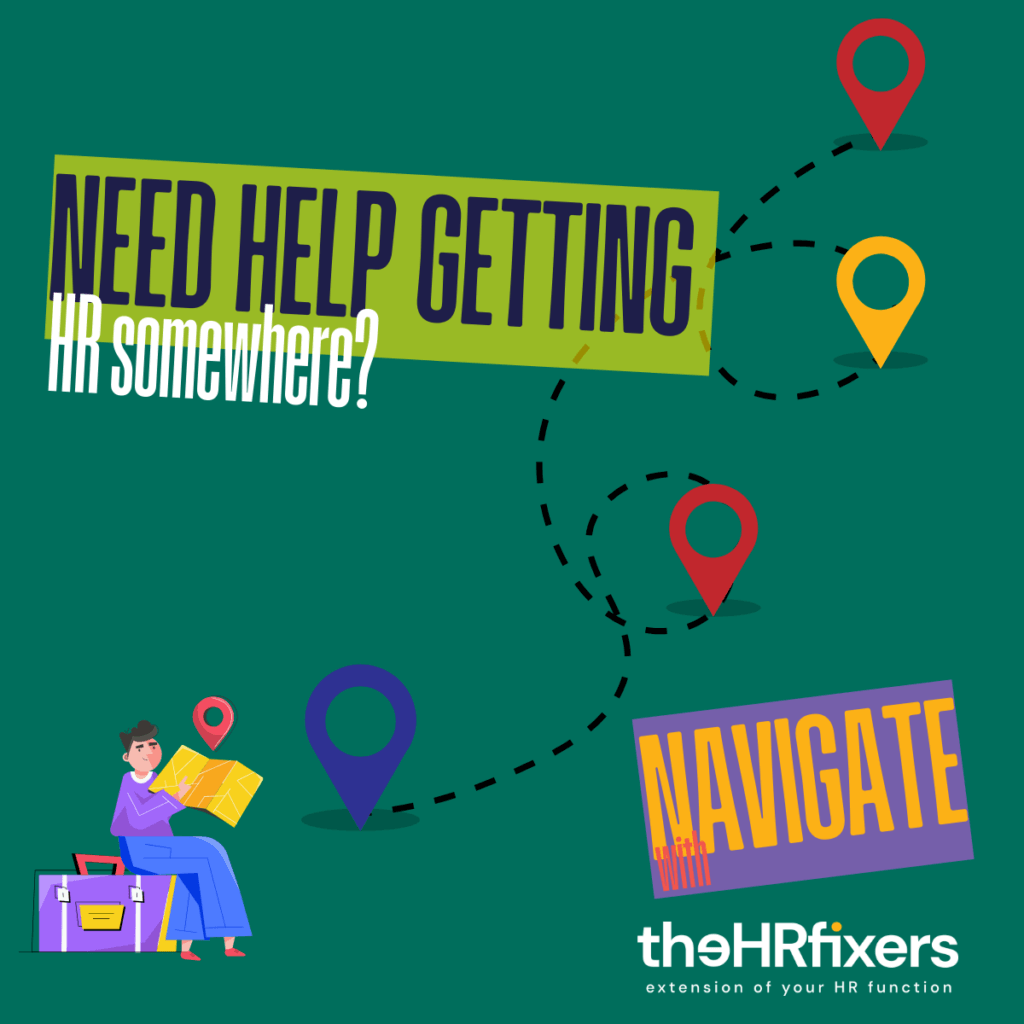CPOs and HR leaders face increasing pressure to drive strategic change while keeping up with evolving technology. The challenge? Finding the right balance between people, process, data and technology to create a truly modern HR function.
That’s where The HR Fixers come in.
Introducing Navigate – our tailored HR change service designed to help organisations define, plan, and execute a successful shift – from admin to active workforce optimisation.
Why Navigate?
The road to HR transformation is often unclear. Whether you’re adopting new technology, reworking your HR processes, trying to visualise workforce data or building a future-ready people strategy – getting started can be overwhelming.
Our Navigate service provides clarity, structure, and expert guidance to set you on the right path.
We don’t just hand you a strategy; we work alongside your team as an extension of your people function to ensure every step is practical, actionable, and tailored to your business needs. We help you balance the plan to ‘change’ and ‘run’ the function in parallel.

What does navigate include?
- Building the case for change: we help you define the “why” behind your transformation, using data-driven insights and stakeholder engagement to create a compelling vision.
- HR and digital assessment: our experts conduct a deep dive into your current processes, technology, and organisational readiness to identify strengths, gaps, and opportunities.
- Project initiation: our approach is to understand your unique business context, enabling us to initiate a project that delivers efficiency, keeps your employees engaged, and helps your business stay flexible and successful in an ever-evolving business landscape.
- Market and vendor selection: choosing the right HR tech is critical. We guide you through the market to select the best-fit HRIS solution and implementation partner. Or we’ll work with what you’ve already got!
- Design: our HR and tech expertise supports you through the detailed design process, empowering your teams to design their future.
- Complemented by our HR Advisory service: offering clear, practical advice to improve your HR operations. We help with everything from restructuring your team to managing talent and adopting best practices. Ensuring you achieve a balance between ‘run’ and ‘change’.
The HR Fixers’ difference
Unlike traditional consultancies, we don’t just advise — we do. We are experienced HR, data and tech professionals who work alongside your team, making transformation seamless and practical. We simplify complexity, break down barriers, and ensure your HR function is fit for purpose, data-enabled, and truly value-driven.
Are you ready to Navigate your HR change?
If you’re looking to move beyond outdated HR practices and away from the admin-heavy-excel-spreadsheets, and embrace a future-ready approach, The HR Fixers’ Navigate service is your roadmap to success.
Let’s start the journey together.
Reach out today to see how we can help you redefine HR for your organisation.
In today’s fast-paced business environment, transformation is a constant. Whether it’s adapting to new technologies, evolving company culture, or implementing strategic HR initiatives, Chief People & Culture Officers (CPCOs) are at the forefront of change. However, too often, we see these transformations managed as isolated initiatives — HR digitalisation over here, a DEI strategy over there, and leadership development somewhere in the mix.
The problem?
Managing transformation in silos leads to inefficiencies, misalignment, and a failure to deliver sustainable impact. Instead, CPCOs must approach transformation as a portfolio of projects, ensuring strategic alignment, resource optimisation, and long-term success. However, so often HR teams are already overloaded by the day job.
How can they possibly manage, guide and sponsor change on top?
The pitfalls of managing HR transformation in isolation
When HR transformation initiatives are managed separately, several common challenges emerge:
1. Lack of visibility
A suite of projects that don’t make visible the holistic add-up can be confusing for stakeholders and lead to duplication. For the CPCO, this can lead to a disjointed narrative and an inability to see the combined benefits being delivered. Investment in HR is challenging to secure at the best of times, so when you get it – keep it! Make the work, outcomes and benefits easily visible for everyone, through a portfolio management approach.
2. Lack of alignment
HR initiatives often tie into broader business goals like growth, efficiency, and employee engagement. When transformation projects are treated as standalone efforts, they may not align with overarching corporate objectives. For example, implementing an AI-driven recruitment tool without integrating it into the company’s talent strategy can result in inefficiencies rather than improvements.
3. Competing priorities and resource constraints
HR teams have limited time, budgets, and people. When multiple initiatives are launched independently, they often compete for resources, leading to delays or half-baked implementations. A leadership development program might lose momentum because all resources have shifted to an HR tech rollout — leaving both initiatives under-delivering. The HR team don’t have the extra time (or skill or capability sometimes) to resource all the change, on top of the day job.
4. Change fatigue and resistance
Employees and managers can only handle so much change at once. When transformation initiatives roll out in silos, employees feel like they are constantly being hit with new processes and tools without understanding the bigger picture. This can lead to resistance, disengagement, and a failure to fully embed the changes. The same can be said of the team leading it, those within HR – unless the portfolio is well planned, easily communicated and everyone is bought into the ‘why’ and ‘how’.

5. Missed opportunities for synergy
HR initiatives are often interconnected:
- Performance management ties into leadership development.
- Employee experience links to digital HR tools.
- DEI efforts impact recruitment and retention.
When projects are managed separately, organisations miss opportunities to leverage insights, integrate technologies, and drive cohesive cultural change. The communications plan that underpins this change needs a synchronised portfolio to knit together the story and help make the change stick.
These pitfalls are similar to everyone jumping in a boat, grabbing an oar and pulling in their own direction, whilst the cox-person shouts random instructions at no-one in particular.
Wouldn’t it be better, if everyone sat comfortably in the same boat, pulled in synchronicity, following a clear plan, to aim for the win?
Managing a portfolio of HR initiatives
To avoid these pitfalls, CPCOs should take a portfolio approach to transformation. This means viewing all HR initiatives and projects, as interconnected deliverables within a larger transformation roadmap, ensuring they work together to deliver business outcomes.
Use an excerpt from our NAVIGATE phase, to ensure the key steps to portfolio management in an HR Transformation are set up for success:
1. Define the strategic vision
Start by identifying the overarching people strategy and how different transformation initiatives contribute to that vision. Ensure that every project aligns with the business’s long-term objectives. It doesn’t need to be rocket science, a vision maybe as simple as:
TOP TIP :
- To transform HR into a strategic powerhouse that enhances employee experience, fosters innovation, and supports agile business growth.
- Building a digitally enabled, insight-driven HR function that empowers people, optimises processes, and drives organisational excellence.
- Shaping a high-performing, inclusive, and adaptable HR ecosystem that attracts, develops, and retains top talent through innovation and continuous improvement.
2. Prioritise and sequence initiatives
Not all projects need to be executed at once. Map out initiatives based on urgency, impact, and dependencies. This prevents resource strain and ensures smooth implementation.
TOP TIP:
- A great way to do this is to engage the team and ask them to prioritise the list of initiatives based on their view of benefit to be delivered.
- A bottom-up approach instead of top-down.
- This approach is powerful to secure team buy-in.
3. Streamline governance and oversight
Appoint a transformation steering committee or a dedicated team to get visibility of the whole portfolio. This group ensures alignment, tracks progress, celebrates success and makes decisions to course-correct when needed.
TOP TIP:
- Make it the one meeting a month they don’t ever miss!
4. Integrate technology and data
HR tech implementations should not happen in isolation. Integrate new tools with existing systems to create a seamless digital employee experience. Use valuable data to measure the benefit of transformation initiatives and adjust as needed.
TOP TIP:
- Identify how you measure success early in the governance cycle.
- Use these metrics to track how it’s going, and adjust them as the portfolio evolves.
5. Support with a strong story
Take a proactive approach to change management, through a compelling story. The internal comms team can help develop this narrative to ensure employees understand how different initiatives connect to the bigger picture. Clear communication, leadership visibility to champion the change, and employee engagement communications are crucial for success.
The HR Fixers’ take
At The HR Fixers, we help organisations shift from fragmented HR projects to strategic, interconnected transformation portfolios. Whether you’re implementing SAP SuccessFactors, redefining your talent strategy, or driving cultural change, we ensure your HR transformation delivers long-term value that everyone can see.
Are you ready to rethink how you manage transformation? Let’s fix it together.
#HRTransformation #PeopleStrategy #TheHRFixers #CPCO #CHRO


